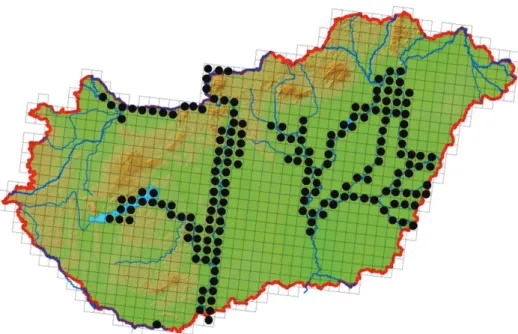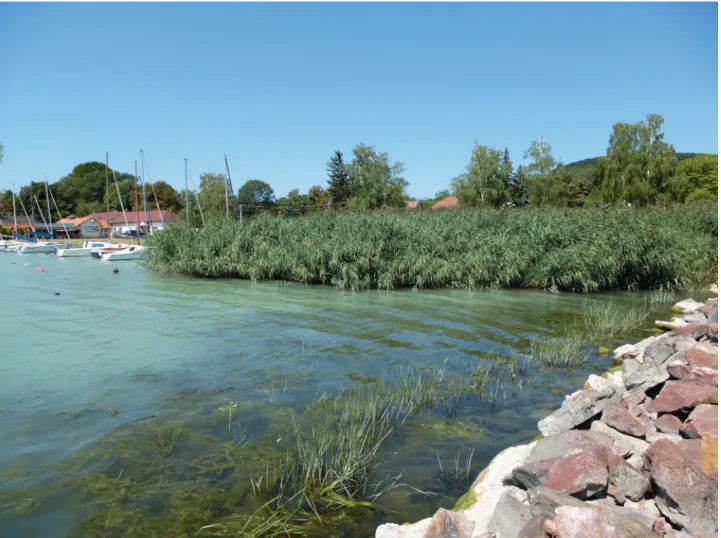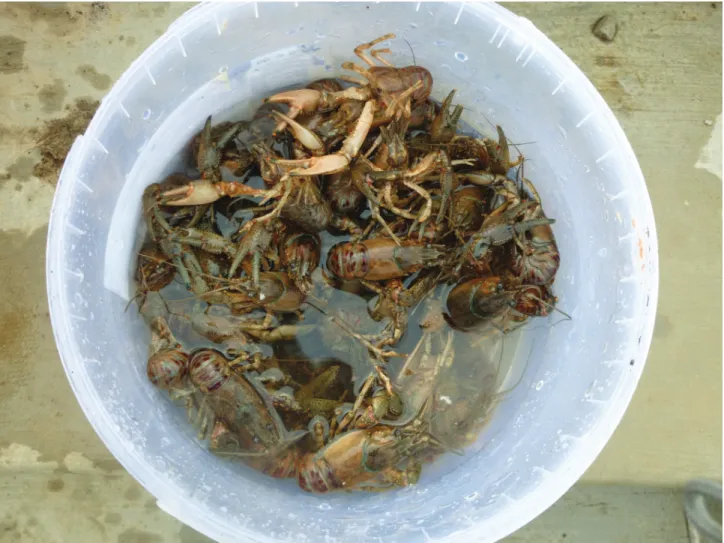AbstrAct
Several non-native crayfish species represent a particularly successful group of invasive species in freshwaters, hence their introductions represent one of the main threats to freshwater biodiversity and ecosystem function. In Hun- gary the noble crayfish (Astacus astacus), the narrow- clawed crayfish (Pontastacus leptodactylus) and stone crayfish (Austropotamobius torrentium) are the native crayfish species. Besides seven non-native Decapoda spe- cies, spiny cheek crayfish (Faxonius limosus), signal crayfish (Pacifastacus leniusculus), marbled crayfish (Procambarus virginalis), red swamp crayfish (Procambarus clarkii), Aus- tralian redclaw crayfish (Cherax quadricarinatus), Chinese mitten crab (Eriocheir sinensis) and Mexican dwarf cray- fish (Cambarellus patzcuarensis) are known to be present in different habitats of Hungarian water bodies. The spiny cheek crayfish is currently one of the most prominent aquatic macroinvertebrates in many european countries.
The first record of this decapod in Hungary was in 1985 in a side arm of River Danube. Its occurrence in the Sió Canal was first reported in 2004. This study provides a summary of the presence of the spiny cheek crayfish and the dynam- ics of its distribution in Lake Balaton.
keywords: decapoda, cambaridae, stocking, active expansion, marbled crayfish, Australian redclaw crayfish
current stAtus And dIstrIbutIon of non-nAtIVe sPIny cheek crAyfIsh (FAXONIUS LIMOSUS
rAfInesQue, 1817) In lAke bAlAton
RICHáRD sePrÕs1,2* - ANNA fArkAs1 - ADRIeN sebestyén3 - ANDOR lÕkkös4 - BeRNADeTT kelbert4 - BLANKA gÁl5 - MIKLóS Puky†6 - ANDRáS weIPerth6,7
1Herman Ottó Institute Nonprofit Ltd., H-1223 Budapest, Park utca 2.
2Szent István University, Faculty of Agriculture and environmental Science, H-2100 Gödöllõ, Páter Károly u.1.
3Õrség National Park Directorate, H-9941 Õriszentpéter, Városszer 57.
4Balaton-felvidék National Park Directorate, H-8229 Csopak, Kossuth u. 16.
5MTA Center for ecological Research, Balaton Limnological Institute, H-8237 Tihany, Klebelsberg Kuno u. 3.
6MTA Center for ecological Research, Danube Research Institute, H-1113 Budapest, Karolina út 29.
7Szent István University, Faculty of Agriculture and environmental Sciences, Institute of Aquaculture and environmental Safety, Department of Aquaculture, H-2100 Gödöllõ, Páter Károly u.1.
*Corresponding author: sepros.richard.csaba@hoi.hu; tel.: +36 70 682 4540
IntroductIon
The spiny cheek crayfish (Faxonius limosus Rafinesque, 1817 – Fig. 1) is one of the most abundant non-indigenous crayfish species not only in Hungary, but in most of the european countries too. This decapod crustacean (other names: American crayfish, striped crayfish) originates from the east coast of the United States (Souty-Grosset et al. 2006). In europe, this crayfish was first detected in north-eastern Germany and north-western Poland in 1980 (Schulz and Smietana 2001). At that time it was thought to originate from natural habitation as well as the aquarium trade. Nowadays, spiny cheek crayfish has spread across several european countries (Kouba et al.
2014). It was introduced to Hungary from Germany in the late 1950s for economic purposes (Thuránszky 1960). In the wild, the first records in Hungary were from a large secondary branch of River Danube in 1985 (Thuránszky and Forró 1987). Since then, abundant and spreading populations have colonized the complete Hungarian stretch of the River Danube, with a colonization rate es- timated at 13 km/year (Puky and Schád 2006). The spe- cies also appeared in the River Drava through the River Danube from Hungary (Maguire and Klobučar 2008). The species was found in Slovakia, in the Ipel and Váh rivers (Janský and Kautman 2007, Puky 2009), which are both tributaries of the River Danube. In the second half of the 2000s, the spiny cheek crayfish also reached the drain-
age area of River Tisza (Sallai and Puky 2008) and a dead specimen was also found in Lake Balaton, while several new populations were found in the different side arms and tributaries in the Hungarian section of the River Dan- ube (Bódis et al. 2012). In summer 2013, the first living individuals of spiny check crayfish were found in the Lake Balaton watershed (Ferincz et al. 2014). Since the first re- ported occurrence, several reviews have summarised the current location and status of the spiny cheek crayfish in Hungary (Bódis et al. 2012, Gál et. al. 2018, Györe et al.
2013, Ludányi et al. 2016) (Figure 2).
Individuals of this non-native crayfish species are typically dark brown or olive-green with a transverse brown-red band across the abdominal segments and on the pleura.
Adults reach about 12 cm in total length. The head is planned in top view, before and behind the cervical cav- ity, and there are small spikes at the outer edge of the back shield. The claws are smaller than those of native species compared to its body size (Figure 1). The spiny cheek crayfish adapts very well to different environmen- tal conditions e.g. contaminated canals, eutrophic ponds, and brackish habitats, clean flowing and standing wa- ters. Most of its diet is composed of insect larvae, aquatic plants and other organic matter (plant debris, carcasses of fallen animals), but it also preys on fish and amphibian eggs and juveniles (Weiperth 2016). The highly success- ful colonization and rapid spread of this species is due to its parthenogenetic growth (Puky 2014). The main threat
posed by this species, however, is the fungal disease of North American origin, called crayfish plague (Aphano- myces astaci Schikora, 1903). The species can also serve as an intermediator (vector) as it is resistant to the dis- ease. Unoccupied habitats can easily be conquered by the species, and large populations can develop. Hungar- ian researchers have observed that this species can live with native species, which is also possible since not all spiny cheek crayfish in europe carry crayfish plague (Ko- zubiková et al 2010). As a result, it can be assumed that it cannot only replace native crayfishes, but can also sup- press them. Changes in the ecological status of water- bodies poses a serious risk to native endangered species (Yee 2014). Consequently, the occurrence of F. limosus in Hungary was surveyed within a program focused on the status of this non-native crayfish species in Lake Balaton.
mAterIAl And methods
Nineteen sampling points were surveyed for the crayfish fauna in the watershed of Lake Balaton. Fifteen sampling points were in the four basins of Lake Balaton, one in the thermal outflow of Lake Héviz, two in north-part tributaries (eger-víz, Lesence-stream) and one in the Sió Canal. The crayfish fauna of Lake Balaton was monitored and sampled using baited crayfish traps, different types of handling nets and electrofishing (DeKA 3000 Lord).
The samplings were done within three seasons (spring-
figure 1: Adult male spiny cheek crayfish from lake balaton at szántód, captured from the deep-water zone of ferry harbour (Photo: András weiperth)
summer-autumn) in all sampling areas between 2015 and 2017. Besides our dataset, records made within Balaton- felvidék National Park were summarised. Field staff from the Balaton-felvidék National Park measured the cray- fish fauna with crayfish traps in 16 west- and south-part tributaries (Bédai-víz, Tetves-stream, Kiskomáromi Canal, Pogány-völgyi-víz, Jaba-stream, Páhoki Canal, River zala, egyesített-övcsatorna, Gyöngyös-stream) between win- ter 2016 and summer 2018. Our field datasets were used
to show the current status and help to understand the dynamics of spiny cheek cray- fish spread in Lake Balaton.
results
In the two research programs, a total of 76 spiny cheek cray- fish individuals were sampled in Lake Balaton and in the Sió Canal (Figure 3). During the field sampling the native no- ble crayfish (Astacus astacus) was sampled in the Berdai-víz, Kiskomáromi Canal, Jaba- stream, Pogány-völgyi-víz, Tetves-víz, zala River and the native narrow-clawed crayfish (Pontastacus leptodactylus) only from Lake Balaton. The marbled crayfish (Procamba- rus virginalis) occurred in west- part tributaries and in the Kes- zthely basin of Lake Balaton.
Two adult female individuals of Australian redclaw crayfish (Cherax quadricarinatus von Martens, 1868) were sampled in the thermal outflow of Lake Héviz in summer and autumn 2017. Besides the crayfish spe- cies, 1361 individuals of 27 fish species were sampled.
We recorded the presence of non-native round goby (Ne- ogobius melanostomus) in Lake Balaton at Siófok, and in the upper section of Sió Canal (Weiperth 2018).
dIscussIon
Currently two native and three non-native decapods have been reported in the watershed of Lake Balaton. Based on our results, the spiny cheek crayfish is the most abundant and wide- spread non-native crayfish species in the whole catch- ment of Lake Balaton. Ferincz et al. (2014) found the first living individuals of this species in a private pond in the Jamai-stream. Thereafter, the species has been detected in the stream and in the estuarine habitats of Lake Balaton (Figure 3). In the middle of 2000 and at the same time that the first data was published, the spread
figure 2: the present distribution of the spiny cheek crayfish (Faxonius limosus) in hungary. map summarises the data from bódis et al. (2012), györe et al. (2013), ludányi et al. (2016) and gál et. al (2018)
figure 3: map of the study area and sampling stations (map: nguyen et al. 2005)
the wgs84 coordinates of locations with the spiny cheek crayfish presence are depicted in black circles
figure 4: harbor at révfülöp at lake balaton, which is a preferred habitat of faxonius limosus (Photo: weiperth András)
of the spiny cheek crayfish was observed from lower and middle section of the Sió Canal (Puky 2004, Puky et al. 2005, Miklós Puky unpublished data). Moreover, it is important to note that several non-native Ponto-Caspi- an goby species originated from the direction of the Riv- er Danube, and in the near future, several goby species could potentially spread into Lake Balaton (Czeglédi et al. 2018). Overall, we can ascertain that the spiny cheek crayfish appeared and spread from several directions of Lake Balaton. The accidental or intentional stocking of this species near the Sió Canal has been proceeded by a relatively fast colonisation and spread of this species throughout the watershed of Lake Balaton.
conclusIons
In the last five years, several new non-native decapod species appeared not only in the Carpathian Basin but in the entire watershed of Lake Balaton. Among these non-native species, the spiny cheek crayfish colonised the
greatest number of aquatic habitats in Hungarian water bodies (Ludányi et al. 2016, Gál et al. 2018). This highly- adaptable, non-native crayfish is known to be an ecosys- tem engineer and could potentially modify various envi- ronmental and biological processes in the locality. Based on the findings we have presented, we can conclude that this North-American crayfish species has been a mem- ber of the local fauna of the Lake Balaton watershed in the last five years since the first individual was recorded in this locality. This observation is important for conser- vationists, wildlife managers, hobby keepers and other stakeholders.
Acknowledgments
The research program was supported by the UNKP-17-3 New National excellence Program of the Ministry of Hu- man Capacities. The english was proofread by Andrew J. Hamer.
references
1. Bódis e., Borza P., Potyó I., Weiperth A., Puky M., Guti G. (2012): Invasive mollusc, macrocrustacea, fish and reptile species along the Hungarian Danube section and some connected waters. Acta zoologica Aca- demiae Scientiarum Hungaricae 58 (Supplement 1):
29-45.
2. Czeglédi I., Boros G., Preiszner B., Specziár A., Takács P., Vitál z., erõs T.(2018): Halfaunisztikai vizsgálatok a Sió–csatornán [Investigation of the fish fauna of the Sió Canal]. Pisces Hungarici 12: 33–36.
3. Ferincz, Á., Kováts, N., Benkõ-Kiss, á., Paulovits, G.
(2014): New record of the spiny-cheek crayfish, Or- conectes limosus (Rafinesque, 1817) in the catchment of Lake Balaton (Hungary). BioInvasions Records 3(1):
35–38.
4. Gál, B., Kuříková, P., Bláha, M., Kouba, A., Jiří, P., Danyik, T., Farkas, A., Farkas, J., Weiperth, A. (2018): Distribu- tion of Decapoda in Hungary and the impacts of the invasive red swamp crayfish (Procambarus clarkii, Gi-
rard 1852) to the native ecosystem. 5th european Con- gress of Conservation Biology - eCCB 2018, 12-15. 06.
2018., University of Jyväskylä, Finnland. https://peera- geofscience.org/conference/eccb2018/107373/
5. Györe, K., Józsa, V., Gál, D. (2013): The distribution of crayfish (Decapoda: Astacidae, Cambaridae) popula- tion in Cris and Mures rivers crossing the Romanian- Hungarian border. AACL Bioflux 6 (1): 18–26.
6. Janský, V., Kautman, J. (2007): Americký rak Or- conectes limosus (Crustacea: Decapoda: Cambaridae) už aj na Slovensku. Acta Rerum Naturalium Musei Na- tionalis Slovaci 53: 21–25.
7. Kouba, A., Petrusek, A., Kozák, P. (2014): Continental- wide distribution of crayfish species in europe: update and maps. Knowledge and Management of Aquatic ecosystems (413): 5.
8. Kozubíková, e., Puky, M., Kiszely, P., Petrusek, A. (2010):
Crayfish plague pathogen in invasive North American crayfish species in Hungary. Journal of Fish Diseases 33:
925–929.
9. Ludányi, M., Peeters, e.T.H.M.e., Kiss, B., Roessink, I.
figure 5: faxonius limosus specimens collected at békésszentandrás along river hármas-körös (Photo: Weiperth András)
(2016): Distribution of crayfish species in Hungarian waters. Global ecology and Conservation 8: 254–262.
10. Maguire, I., Klobučar, G. (2008): Appearance of Or- conectes limosus in Croatia. Crayfish News 25(3): 7.
11. Nguyen, H.L., Leermakers, M., Osán, J., Török, S., Baey- ens, W. (2005): Heavy metals in Lake Balaton: water column, suspended matter, sediment and biota. Sci- ence of the Total environment 340 (1-3): 213–230.
12. Pârvulescu, L., Paloş, C., Molnar, P. (2009): First record of the spiny-cheek crayfish Orconectes limosus (Rafin- esque, 1817) (Crustacea: Decapoda: Cambaridae) in Romania. North-Western Journal of zoology, 5(2):
424–428.
13. Puky, M. (2004): zoological mapping along the Hun- garian lower Danube: Importance, aims and necessity discussed with the example of tree unrelated groups, Decapoda, Amphibia and Reptilia. Limnological Re- ports 35: 613–618.
14. Puky, M. (2009): Confirmation of the presence of the spiny-cheek crayfish Orconectes limosus (Rafinesque, 1817) (Crustacea: Decapoda: Cambaridae) in Slovakia.
North-Western Journal of zoology 5(1): 214–217.
15. Puky, M. (2014): Invasive Crayfish on Land: Orconectes limosus (Rafinesque, 1817) (Decapoda: Cambaridae)
Crossed a Terrestrial Barrier to Move from a Side Arm into the Danube River at Szeremle, Hungary. Acta zoo- logica Bulgarica Supplement 7: 143–146.
16. Puky, M., Reynolds, J.D., Schád, P. (2005): Native and alien Decapoda species in Hungary: Distribution, sta- tus, conservation importance. Bulletin Français de la Pêche et de la Pisciculture 376–377: 553–568.
17. Puky, M., Schád, P. (2006): Orconectes limosus colo- nises new areas fast along the Danube in Hungary. Bul- letin Français de la Pêche et de la Pisciculture 380-381:
919–926.
18. Sallai z., Puky M., 1998. A „Nimfea” természetvédelmi egyesület Halfaunisztikai Munkacsoportjának rák- (Decapoda), kétéltû- (Amphibia) és hüllõ- (Reptilia) faunisztikai adatai. A Puszta, 15, 137-154.
19. Schulz, R., Smietana, P. (2001): Occurrence of native and introduced crayfish in northeastern Germany and northwestern Poland. Bulletin Francais de la Pęche et de la Pisciculture 361: 629–641.
20. Souty-Grosset, C., Holdich, D.M., Noel, P.Y., Reynolds, J.D., Haffner, P. (edit.) (2006): Atlas of Crayfish in eu- rope.Collection Patrimoines Naturels, 187 pp.
21. Thuránszky, z. (1960): A ráktelepítésrõl se feledkezzünk meg! Halászat 7: 37.
22. Thuránszky, M., Forró, L. (1987): Data on distribution of freshwater crayfish (Decapoda:Astacidae) in Hunga- ry in the late 1950s. Miscellanea zoologica Hungarica 4: 65–69.
23. Weiperth, A. (2016): Cifrarák, jelzõrák, vörös mocsárrák, kínai gyapjasollós rák. In: Botta- Dukát z. (szerk.) Inváziós fajok terjedési útvonalainak átfogó elemzése és hazai ér- tékelése. Kutatási zárójelentés. Kézirat: 136–155.
24. Weiperth, A. (2018): A feketeszájú géb (Neogobius melanostomus) elsõ észlelése a Balatonban. Halászat 111 (3): 89.
25. Yee, D.A. (2014): ecology, Systematics, and the Natu- ral History of Predaceous Diving Beetles (Coleoptera:
Dytiscidae). Spronger, p. 468.


